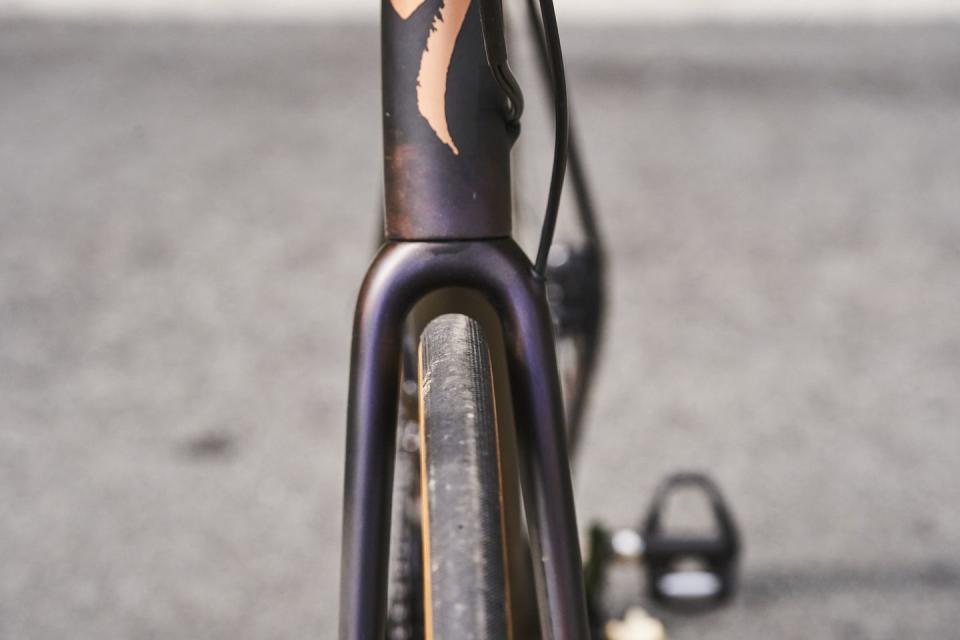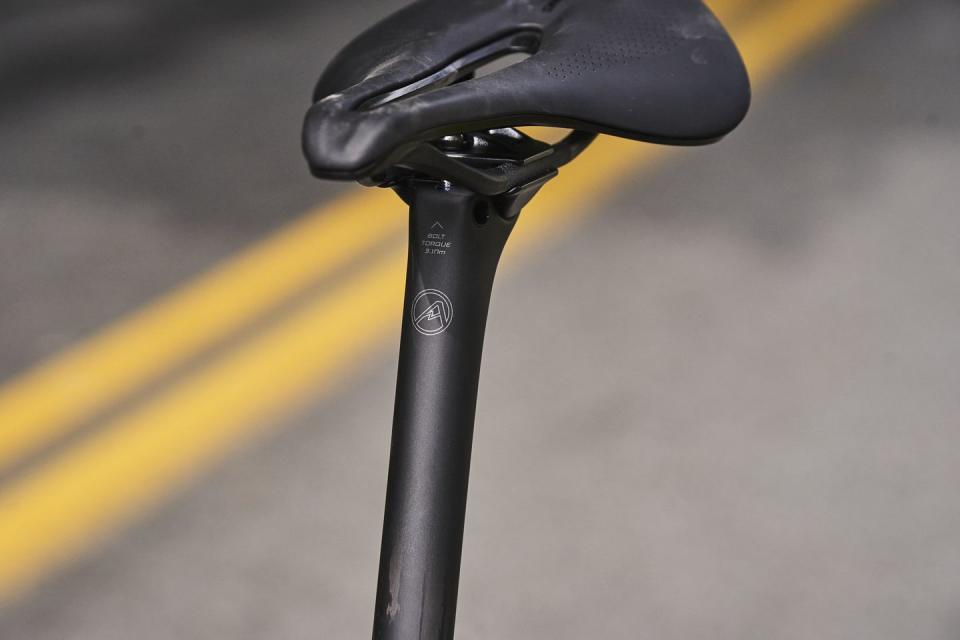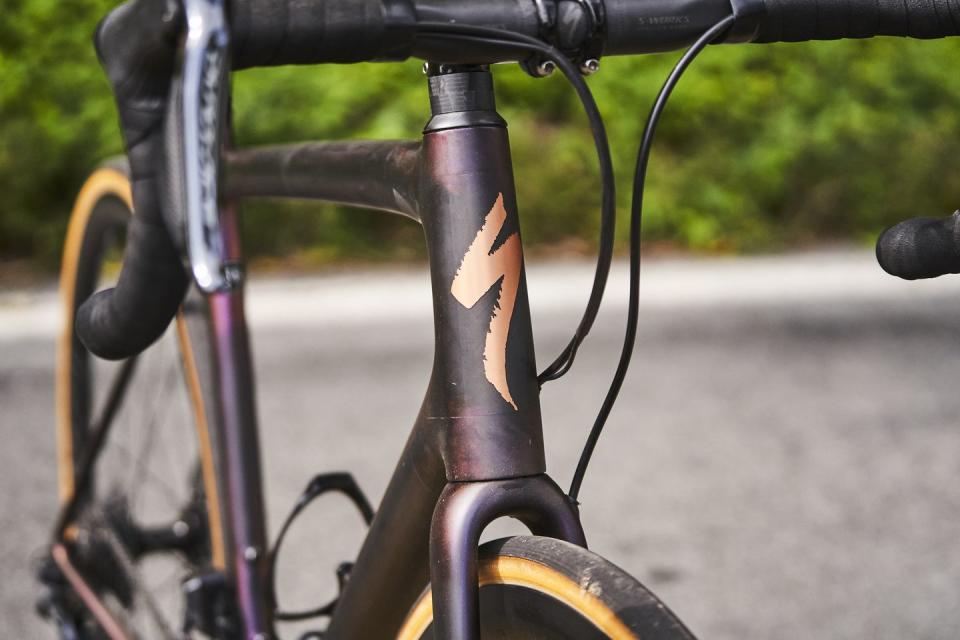The Specialized Aethos Is the Most Exciting New Road Bike of 2020
The Takeaway: The Aethos rides like a Tarmac, but is simple and user-friendly in a way modern road bikes haven’t been for years.
No proprietary components
Same geometry and strength-to-weight ratio as the Tarmac SL7
Insanely light
Price: $12,500
Weight: 14.3 lb. (58cm)
MORE IMAGES
The latest road bike from Specialized is just that: a road bike. A traditional road bike void of fancy tube shapes and handlebar configurations—and any other design element that doesn’t substantively add to the quality of the ride. At the heart of the Aethos is a pure focus on a great cycling experience, not going fast and winning races. There’s nothing obviously aero about it, internal brake-hose routing is minimal, and the traditional stem and round handlebar look old-fashioned when compared to the slick integrated cockpits on many bikes. In other words, it’s everything we’re NOT used to seeing on a modern-day road bike. At just over 14 pounds, it’s one of the lightest we’ve tested, but that in itself isn’t extraordinary. The Aethos stands out because it’s a bike for discerning riders who enjoy and appreciate the performance of racing bikes but are more concerned with having a great ride than being first across the finish line.
Though the Aethos has the aggressive fit, tight handling, and incredible pedaling efficiency of a race bike, it’s far more user-friendly than most race bikes available today. “Riding doesn’t have to be defined by racing,” says Specialized Road and Gravel Project Leader, Stewart Thompson. “The Aethos came from a desire to make a bike for ourselves and our rides that is different from race targets.” It’s for riders who want that level of performance without the headaches that come from crazy integration and proprietary parts.
5 Things We Love About The Specialized S-Works Aethos
Tarmac-Inspired Geometry
As beautifully simple as this bike is on the surface, it’s every bit as high-tech as Specialized’s other top-tier bikes. In fact, frame construction lessons learned during the Aethos project are found in both the 2019 Epic hardtail and the Tarmac SL7 the company released earlier this summer.
The Aethos even matches the Tarmac SL7 in all of the brand’s stiffness-to-weight measurements, and its race-inspired geometry is nearly identical. Our 58cm test bike has 591mm of stack (the SL7’s is 581), 402mm of reach (405 on the SL7), and 73.5-degree head and seat angles (same as a 58cm SL7). It also bears an uncanny resemblance to the Tarmac SL5, the first model to launch with Specialized’s Rider-First Engineered approach to frame design, which tweaks tube size and carbon layup to optimize performance across all sizes.

Specialized S-Works Aethos Details
Style: Road
Material: Carbon
Drivetrain: Shimano Dura-Ace Di2
Cranks: 175mm Shimano Dura-Ace with dual-sided power meter
Chainring: 52/36
Cassette: 11-28
Brakes: Shimano Dura-Ace Hydraulic Disc
Wheels: Roval Alpinist CLX
Tires: Specialized Turbo Cotton
Saddle: Specialized S-Works Body Geometry Power
Seatpost: Roval Alpinist Carbon
Handlebar: Specialized S-Works Short & Shallow
Stem: Specialized Pro SL, alloy
Tire Clearance: 32mm
The Result of Extensive Testing: Round Tubes Work
The biggest change here is tube shape. Rather than rely on the carbon layup to create the desired ride qualities, Specialized engineers focused on tube shape. That stands in stark contrast to how aero road bikes are designed, where the aerodynamically optimized shape comes first and then engineers determine the proper carbon layup to make it perform. Often that leads to parts of the bike being overbuilt in order to compensate for a tube shape that performs well in the wind tunnel, but on its own doesn’t fare well against the forces it must handle.

Since the primary concern with the Aethos was ride quality, and the engineers at Specialized weren’t aiming to conform to UCI rules (although the end result does), they started with finding the optimal tube shapes to create a bike with class-leading stiffness-to-weight ratio and a ride quality that mimics the crisp handling, incredible efficiency, and all-day comfort of the Tarmac. The head tube is round and slightly tapered with no visible aero styling, and the down tube is round where it meets the head tube, tapering to a flattened oval shape at the bottom bracket. The seatstays and top tube also look very traditional: The former are skinny and round, and the latter has a slight convex shape to it. The svelte seat tube fits a 27.2mm seatpost and, like the down tube, is ovalized at the bottom bracket. The bottom bracket is remarkable as well, not only for the noticeable lack of material, but also for the user-friendly, threaded BSA bottom bracket shell.

Technology aside, we can’t ignore the fact that the most exciting thing about the Aethos is that it’s a throwback to the way bikes used to be before design went nuts chasing the aerodynamic holy grail. Although this way of thinking may be new for Specialized, independent frame builders the world over have known all along that simple works, and you don’t need a bike that resembles a spaceship to have a great ride.
The Aethos Family
There are two S-Works versions: the Shimano Dura-Ace Di2 we reviewed and one with SRAM RED eTap AXS. Both cost $12,500 and roll on Roval Alpinist CLX wheels. The bottom bracket and derailleur pulleys are packed with CeramicSpeed bearings, and the one-piece cockpit from Roval adds some flair but detracts from some of the simplicity that makes the Aethos such a wonderful bike.
There’s also a $14,500 Founder’s Edition, of which only 300 will be sold. It uses the same frame, drivetrain, and wheels as the S-Works model but adds a Roval Alpinist integrated one-piece bar/stem cockpit and CeramicSpeed derailleur pulley wheels.

How the Aethos Rides
I was smitten from the first pedal stroke. Aero bikes are cool, but there is something deeply enchanting about the way an ultralight road bike dances beneath you when you stand on the pedals. The Aethos is light, snappy, and lively on climbs—as you’d expect from a 14-pound bike—yet stiff and responsive when you’re out of the saddle. Even though I was confident the bike was strong and reliable, I was hesitant at first to give it some stick in a full-gas sprint. The bike is so damn light, I was sure it wouldn’t respond well. Boy, was I wrong. At 6-foot-2 and roughly 180 pounds I can usually put enough force into the pedals to expose any inherent weaknesses. What I found was an incredibly stiff bike that had just the right amount of give, producing a spring-like feeling with each pedal stroke as the bike moved beneath me at full power.
But there’s more to the Aethos than just good feelings when blasting up a hill or sprinting toward the town line. It’s smooth and comfortable while cruising down the road, but not so smooth that you feel removed from the pavement. You get just the right amount of feedback from the road that you can feel the grip your tires have (or don’t have) when leaning hard into a hairpin turn. And the bike’s weight limit, claims Specialized, is 275 pounds, meaning you don’t have to be a featherweight to enjoy it.
If you’re wondering why this isn’t a race bike, you’re not alone. Five years ago, the Aethos would have just been a Tarmac. Without at least token attention paid to cheating the wind, right now it’s tough to sell a $12,500 racing bike that ignores the free speed that comes with an aero frame. Even climbing bikes have aero touches.
The Aethos doesn’t limit your fit preferences, lock you into a proprietary ecosystem of parts, or complicate things where they don’t need to be. It’s just a simple, straight-up, high-performing road bike that also happens to be worthy of racing.

You Might Also Like

